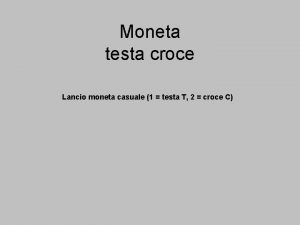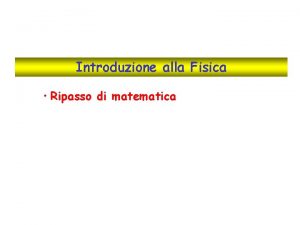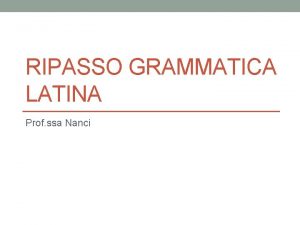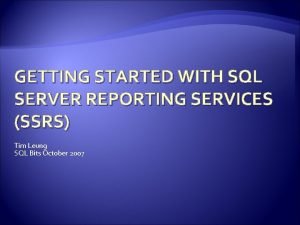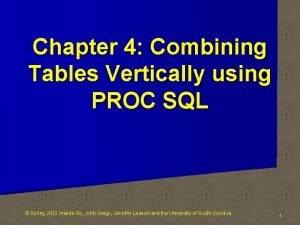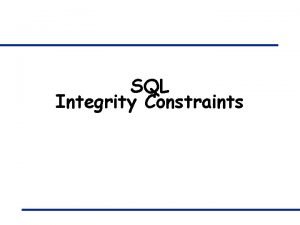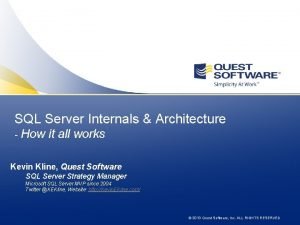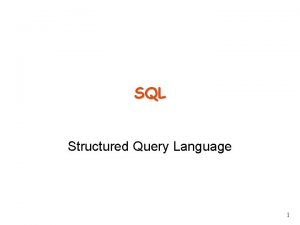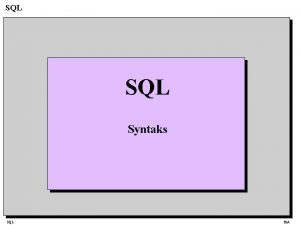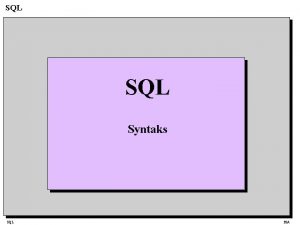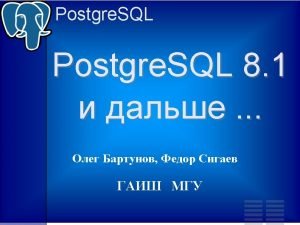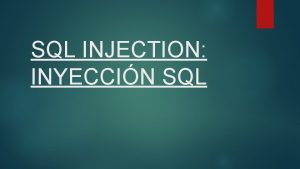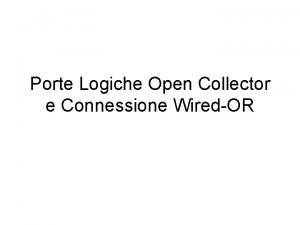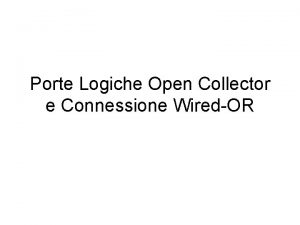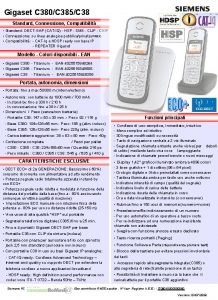My SQL Esercitazioni Ripasso Connessione a My SQL



















- Slides: 19

My. SQL Esercitazioni

Ripasso ● Connessione a My. SQL. ● Creazione delle basi di dati e delle tablelle. ● Inserimento dei dati. ● Interrogazioni.

Alcuni Esercizi ● ● Descrizione della struttura di SDB (Sequence Data. Base). Descrizione dei principali campi di SDB.

Struttura dell'SDB ● ● Base di dati Relazionale, costituita da tabelle di tipo myisam. Utilizzato per registrare i dati di: Sequenze Nucleotidiche; – Esecuzioni di Blast; – Esecuzioni di Clustering. –

Tabelle delle Sequenze ● SAMPLE_PLAN. ● CONTAINER. ● REPORTER. ● DUPLICATES. ● MAPPING_8 KRG.

Tabelle dei Blast ● BLAST_EST. ● BLAST_GEN. ● BLAST_NORM.

Tabelle di Clustering ● CLUSTERS_CONSENSUS.

Alcuni Campi della Base di Dati ● Testo delle Sequenze. ● Campi di Blast_gen: – – Chromosome; Contig_start; STS; Homology. Perc.

Esercizio 1 ● Selezionare gli identificatori e la lunghezza delle sequenze più lunghe di 100 paia di basi. – ● ● Selezionare il numero di sequenze più lunghe di 100 paia di basi. Selezionare i risultati di blast (BLAST_NORM) che hanno un evalue maggiore di 10 -100. Selezionare i risultati del blast genomico (BLAST_GEN) che sono più lunghi di 100 paia di basi e che si trovano sul cromosoma 3. – E se volessi quelli sul cromosoma X?

Soluzioni Esercizio 1 ● select Reporter_ID, Length from REPORTER where Length > 100; – ● ● select count(Reporter_ID) from REPORTER where Length > 100; select Reporter_ID, E_Value_Best_Match from BLAST_NORM where E_Value_Best_Match > 1 e-100; select BLAST_GEN. Reporter_ID, BLAST_GEN. Sx, BLAST_GEN. Sy, BLAST_GEN. Chromosome from BLAST_GEN where (BLAST_GEN. Sy. BLAST_GEN. Sx)>100 and BLAST_GEN. Chromosome = 3; – select BLAST_GEN. Reporter_ID, BLAST_GEN. Sx, BLAST_GEN. Sy, BLAST_GEN. Chromosome from BLAST_GEN where (BLAST_GEN. Sy. BLAST_GEN. Sx)>100 and BLAST_GEN. Chromosome = 'X';

Esercizio 2 ● ● Selezionate l'identificatore, la lunghezza ed il cromosoma di tutte le sequenze il cui nome comincia con 5000. Selezionare tutte le sequenze di lunghezza maggiore di 100 che sono in relazione con p 53 (hanno un risultato di blast correlato con un'annotazione di p 53).

Soluzione – Esercizio 2 (1) ● Normale – ● Inner Join – ● select REPORTER. Reporter_ID, REPORTER. Length, BLAST_GEN. Chromosome from REPORTER, BLAST_GEN where REPORTER. Reporter_ID = BLAST_GEN. Reporter_ID and REPORTER. Reporter_ID like '5000%'; select REPORTER. Reporter_ID, REPORTER. Length, BLAST_GEN. Chromosome from REPORTER inner join BLAST_GEN on REPORTER. Reporter_ID = BLAST_GEN. Reporter_ID where REPORTER. Reporter_ID like '5000%'; Natural Join – select REPORTER. Reporter_ID, REPORTER. Length, BLAST_GEN. Chromosome from REPORTER natural join BLAST_GEN where REPORTER. Reporter_ID like '5000%';

Soluzione – Esercizio 2 (2) ● Right Join – ● select REPORTER. Reporter_ID, REPORTER. Length, BLAST_GEN. Chromosome from REPORTER right join BLAST_GEN on REPORTER. Reporter_ID =BLAST_GEN. Reporter_ID where REPORTER. Reporter_ID like '5000%'; Left Join – select REPORTER. Reporter_ID, REPORTER. Length, BLAST_GEN. Chromosome from REPORTER left join BLAST_GEN on REPORTER. Reporter_ID = BLAST_GEN. Reporter_ID where REPORTER. Reporter_ID like '5000%';

Soluzione – Esercizio 2 (3) ● Soluzione – ● Usando left join – ● select REPORTER. Reporter_ID from REPORTER, BLAST_NORM where REPORTER. Reporter_ID = BLAST_NORM. Reporter_ID and REPORTER. Length > 100 and BLAST_NORM. Annotation like '%p 53%'; select REPORTER. Reporter_ID from REPORTER left join BLAST_NORM on REPORTER. Reporter_ID = BLAST_NORM. Reporter_ID where REPORTER. Length > 100 and BLAST_NORM. Annotation like '%p 53%'; Left Join con Using – select REPORTER. Reporter_ID from REPORTER left join BLAST_NORM using (Reporter_ID) where REPORTER. Length > 100 and BLAST_NORM. Annotation like '%p 53%';

Esercizio 3 ● ● Quante sono le sequenze che hanno un match in BLAST_EST con percentuale di omologia maggiore del 99%? Contare il numero di risultati di blast per ogni sequenza di BLAST_NORM. – ● Resituire solo quelli che hanno più di 3 risultati. Le query con order by e limit.

Soluzioni – Esercizio 3 ● Distinct – ● ● select distinct(BLAST_EST. Reporter_ID) from BLAST_EST where BLAST_EST. Homology. Perc > 99 order by. Reporter_ID; Count – select Reporter_ID, count(Ordr) from BLAST_NORM group by Reporter_ID; – select Reporter_ID, count(Ordr) from BLAST_NORM group by Reporter_ID having E_Value_Best_Match > 1 e-100; Order by e limit – select Reporter_ID, E_Value_Best_Match, Chromosome from BLAST_GEN where E_Value_Best_Match=1 e-100 order by Chromosome limit 0, 30

Esercizio 4 ● ● Selezionare, dalla tabella BLAST_NORM le sequenze che hanno lo stesso NCBI_Subject_ID della sequenza 8 RG 3 CGA 11. Per casa: selezionate tutte le sequenze che hanno Poly_C nella stessa posizione della sequenza 5000 ABC 06 o della sequenza 5000 AAE 09. * – ● sugg. provate prima con una sola sequenza. Per casa: trovare quante sono le sequenze che hanno la stessa lunghezza purché diversa da zero. ***

Soluzioni – Esercizio 4 ● ● Self query – select BLAST_NORM 1. Reporter_ID, BLAST_NORM 1. NCBI_Subject_ID, BLAST_NORM 2. NCBI_Subject_ID from BLAST_NORM as BLAST_NORM 1, BLAST_NORM as BLAST_NORM 2 where BLAST_NORM 1. NCBI_Subject_ID = BLAST_NORM 2. NCBI_Subject_ID and BLAST_NORM 2. Reporter_ID = '8 RG 3 CGA 11' order by BLAST_NORM 1. NCBI_Subject_ID; – select Reporter_ID from BLAST_NORM where NCBI_Subject_ID = (select NCBI_Subject_ID from BLAST_NORM where Reporter_ID = '8 RG 3 CGA 11'); Ho detto per casa o no?

Esercizio 5 Costruite una base di dati che abbia le seguenti caratteristiche: ● Mantenga i dati su sequenze nucleotidiche. Testo della Sequenza. – Lunghezza delle sequenze. Mantenga i dati sui ricercatori cui appartengono le sequenze. – ● Dati Anagrafici. – Sequenze possedute. –
 Lanciando una moneta 7 volte
Lanciando una moneta 7 volte Ripasso disequazioni
Ripasso disequazioni Ripasso promessi sposi
Ripasso promessi sposi Amplitudine formula
Amplitudine formula Verrocchio soave
Verrocchio soave Ripasso letteratura italiana
Ripasso letteratura italiana Simboli matematica
Simboli matematica Grammatica latina ripasso
Grammatica latina ripasso Sql developer unit test
Sql developer unit test Difference between sql and plsql
Difference between sql and plsql Visual studio sql debugging
Visual studio sql debugging Sql server memory architecture
Sql server memory architecture Sql
Sql Sql server reporting services architecture
Sql server reporting services architecture Pl/sql cours
Pl/sql cours Sql server in memory oltp
Sql server in memory oltp Outer union corr in sas
Outer union corr in sas Integrity constraints in sql
Integrity constraints in sql Sql server internals and architecture
Sql server internals and architecture Select distinct sql
Select distinct sql
